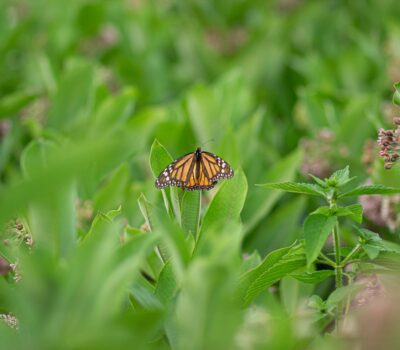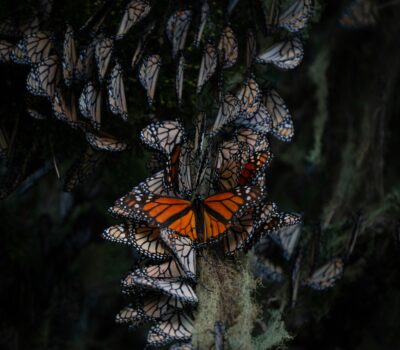Ask a Naturalist: Creating Habitat for Monarch Butterflies
Monarch butterflies aren’t only amazingly beautiful, they are also a symbol of resilience and strength. They travel between 1,200 and 2,800 miles from the Northeast US and Southeast Canada to central Mexico and coastal California. In the mountain forests of Mexico, they find the right weather conditions to hibernate from November to March. The scientific name for Monarch is Danaus plexippus, meaning “sleepy transformation.” Each adult butterflies lives only 4-5 weeks. Due to heavy habitat decline, Monarchs are close to being considered a “threatened” species, but there is a lot we can do to help their population bounce back.
Habitat Loss
Monarchs heavily depend on one plant called Milkweed. They only lay their eggs on Milkweed, and it is the only source of food for baby caterpillars. Unfortunately, urbanization and agricultural expansion have destroyed millions of acres of milkweed, so the Monarch butterfly’s habitat is declining rapidly.
“The development of genetically modified (GMO) Roundup Ready crops has played a major role in the loss of milkweed in agricultural areas. These GMO crops don’t directly harm the butterfly. Rather, it is their ability to resist Glyphosate, a weed killer and the primary active ingredient in Roundup, that has eliminated 99% of the milkweed that once grew in corn and soybean fields,” (WWF).
Another harmful factor is neonicotinoids, a type of neurotoxic insecticide. Although marketed as a safer option for selectively killing pests, neonics have instead made US agriculture 48 times more toxic to most insects, including pollinators. These pesticides are persistent in the environment, infiltrating groundwater and causing largely irreversible effects on invertebrates; thus, affecting the entire food chain.
While the logging of the forests in which Monarchs overwinter, has contributed to the specie’s decline, the impacts of habitat destruction, insecticides, and herbicides within the species breeding grounds along with the effects of climate change, are the major drivers of its decline today.
What can you do to help save the Monarchs?
Planting the right species of milkweed can help these resilient pollinators to bounce back and thrive. When Monarchs start their journey back north, they are looking for plants to lay their eggs and feed on. Milkweed is essential to these pollinators.
You can use the milkweed finder to help you find the right type of milkweed you should plant depending on where you live. This action can make a big difference in the survival of these beautiful insects. https://www.worldwildlife.org/pages/monarch-milkweed-finder
Once you know the type of milkweed you need, find a nursery in your area that sells it. You can find a nursery database at https://shop.milkweedmarket.org/. Make sure your milkweed gets as much sun as possible and it is shielded from the wind so it can thrive in your garden.
You should also plant a variety of other flowering plants that can provide nectar for butterflies. Make sure you have plants that flower at different times so that they can also feed butterflies when they are going back south for the winter.
Other things you can do to help are supporting organizations such as World Wildlife Fund, that are working to change laws affecting Monarch habitats in Mexico and the US. In addition, supporting organizations at the local level is also important. Organizations that create and protect habitats for wildlife such as Piedmont Land Conservancy and Gateway Nature Preserve, are making an impact in our communities to conserve the species and other wildlife.
There are many other ways you can help by learning more about:
- Federal, state, and local governments and laws concerning wildlife
- Agriculture and ranching
- International collaboration
- Home gardens
Check out the resources section for more information about Monarchs and how to help the species thrive.


